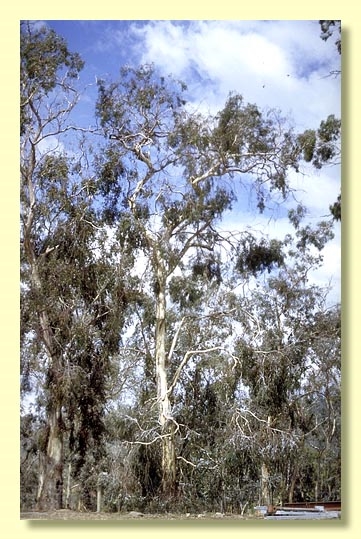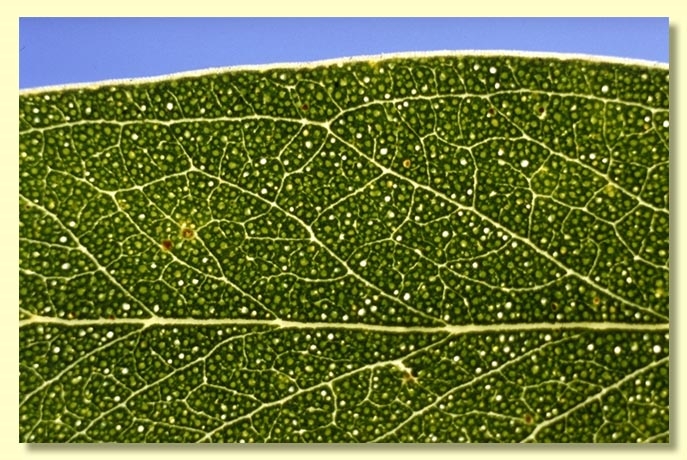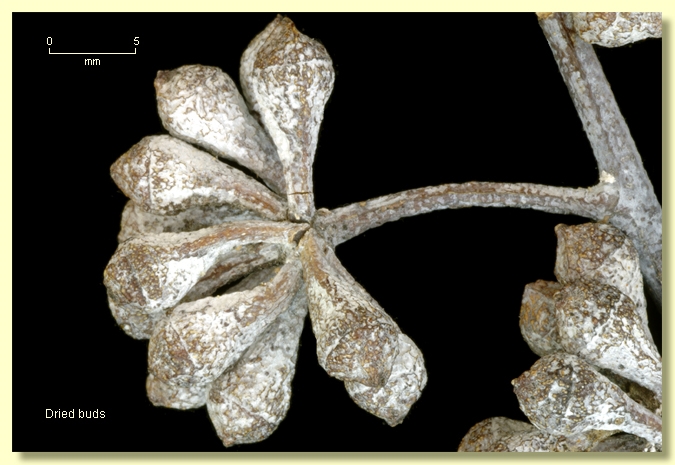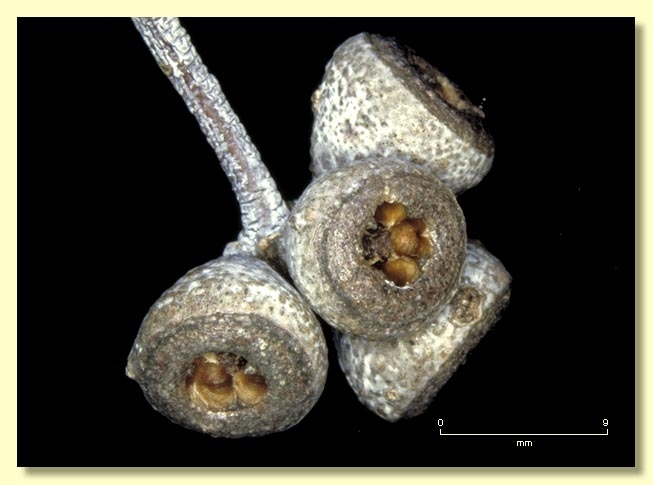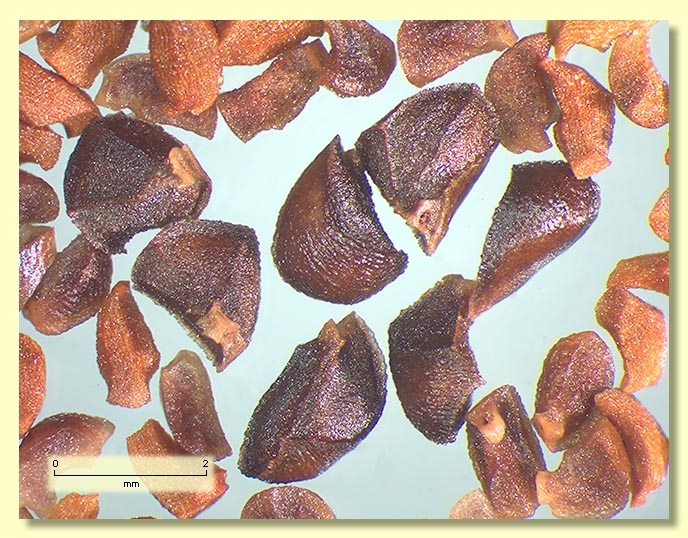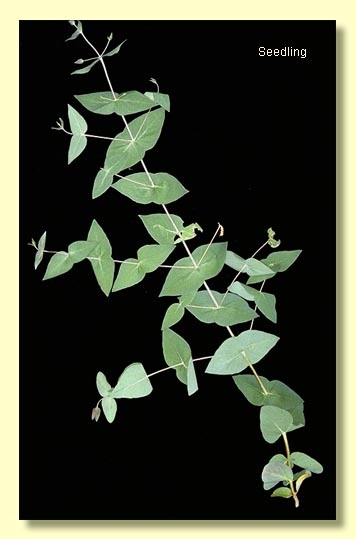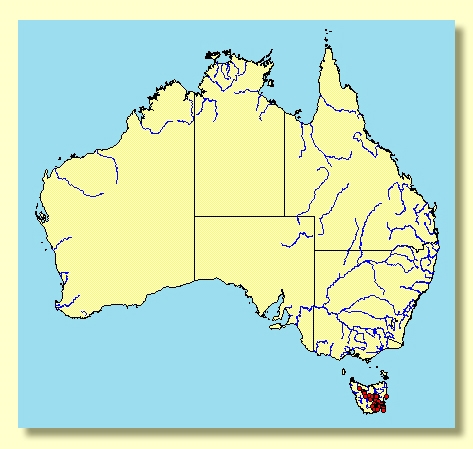Euclid - Online edition
Eucalyptus tenuiramis
Eucalyptus | Eucalyptus | Aromatica | Insulanae
Bark smooth throughout or with a few partly decorticated basal slabs of rough bark; smooth bark white to light grey or yellowish; branchlets glaucous.
Juvenile growth (coppice or field seedlings to 50 cm): stem rounded in cross-section, glaucous, warty; juvenile leaves opposite and sessile until sapling stage, ovate, 1.7–6 cm long, 1–3.8 cm wide, bases connate or free from each other and amplexicaul, blue or glaucous. The glaucous sapling stems show dark rings scars left by fallen connate leaf pairs.
Crown may have opposite, petiolate intermediate leaves as well as adult leaves.
Adult leaves alternate, petiole 0.7–1.2 cm long; blade broadly lanceolate to elliptical, 5.5–13 cm long, 1–2.5 cm wide, base tapering to petiole, concolorous, glossy or dull, green, bluish or glaucous, side-veins at an acute or wider angle to midrib, sparse to moderately reticulate, intramarginal vein parallel to and well removed from margin, oil glands island.
Inflorescence axillary unbranched, peduncles 0.4–1.2 cm long, buds 9 to 15 or more per umbel, pedicels 0.1–0.4 cm long. Mature buds obovoid or clavate, 0.5–0.8 cm long, 0.3–0.4 cm wide, glaucous, smooth or minutely warty only on operculum, scar absent, operculum conical to rounded, stamens mostly inflexed or irregularly flexed, anthers reniform to cordate, versatile, dorsifixed, dehiscing by (usually) confluent slits, style short or long, stigma tapered, locules 3 or 4, the placentae each with 2 vertical ovule rows (but sometimes in 3 rows or not in distinct rows). Flowers white.
Fruit rarely sessile, usually on pedicels to 0.3 cm long, cup-shaped, hemispherical or obconical, 0.5–1.2 cm long, 0.6–1.1 cm wide, glaucous or non-glaucous, disc raised-convex to annular or level, valves 3 or 4, near rim level.
Seeds dark brown, 1.5–2.2 mm long, pyramidal or obliquely pyramidal, dorsal surface smooth, hilum terminal.
Cultivated seedlings (measured at ca node 10): cotyledons reniform; stems rounded in cross-section, warty, usually glaucous; leaves sessile and opposite for many nodes, cordate to lanceolate, 3.5–6.5 cm long, 2.5–5 cm wide, bases connate or amplexicaul, margin minutely denticulate or entire, apex pointed, dull, glaucous or weathering to green.
Flowering has been recorded in January, February, November and December.
A small to medium-sized tree widespread in low hills of south-eastern Tasmania especially in the Derwent River catchment and also the Freycinet Peninsula area.
Eucalyptus tenuiramis is a smooth-barked tree with glaucous branchlets, a mature crown of alternate, petiolate, green to blue-green adult leaves and often some petiolate, opposite, glaucous intermediate leaves. It is closely related to the smooth-barked tree, E. risdonii, which has a crown of glaucous, sessile, often basally connate, juvenile leaves. The high altitude smooth-barked peppermint E. coccifera has similar crown leaves to E. tenuiramis but differs in the manifestly warty operculum.
Eucalyptus tenuiramis belongs to Eucalyptus subgenus Eucalyptus section Aromatica (the peppermints) because the buds have a single operculum, anthers are reniform, ovules are in two rows, seeds are more or less pyramidal, adult leaf venation is more or less acute and juvenile leaves are sessile and opposite for many pairs. Within this section, E. tenuiramis belongs to an endemic Tasmanian series of 7 species, series Insulanae, the other species being E. risdonii (discussed above); E. nitida, a rough or partly rough-barked tree species (rarely almost smooth), with a crown of adult, petiolate, lanceolate, green leaves; E. amygdalina, a rough-barked tree of drier sites and with leaves narrower than E. nitida; E. pulchella, a smooth or partly rough-barked tree with green crown of linear, adult leaves; and E. coccifera, a smooth-barked species of cold, high areas, with glaucous branchlets, elliptical to cordate (non-connate) juvenile leaves and a crown of green, elliptical to lanceolate adult leaves and warty buds in clusters of three, seven or nine. (The other species have buds in clusters of nine or more). The 7th species in series Insulanae is the more recently described E. nebulosa, a small smooth-barked tree with grey-blue crown, restricted to serpentine geology on ridges north-west of Rosebery; it has narrowly elliptical adult leaves in the crown and sessile short broad elliptical juvenile leaves on coppice growth.
The only other peppermint species found in Tasmania is in series Radiatae. It is the common mainland species, E. radiata subsp. radiata, a rough-barked, tall, forest tree restricted, in Tasmania, to the Lemonthyne area. It has a narrow-leaved crown of adult leaves, whilst the lanceolate juvenile leaves have numerous oil glands.

